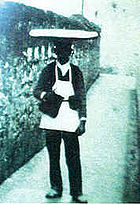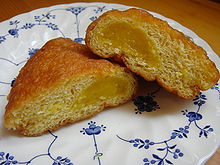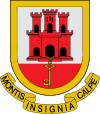- Gibraltarian cuisine
-
Gibraltar 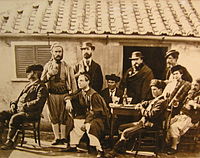
This article is part of the series:
Culture of Gibraltar
- Gibraltarian people
- History of the Genoese in Gibraltar
- History of the Jews in Gibraltar
- History of the Maltese in Gibraltar
- Religion in Gibraltar
- Gibraltarian cuisine
Gibraltarian cuisine is the result of a long relationship between the Andalucian Spaniards and the British, as well as the many foreigners who made Gibraltar their home over the past three centuries. The culinary influences include those from Malta, Genoa, Portugal, Andalusia and Britain. This marriage of tastes has given Gibraltar an eclectic mix of Mediterranean and British cuisine.
Below are some examples of typical Gibraltarian dishes.
Contents
Pasta
Rosto
Popular local pasta dish of Italian origin consisting of penne in a tomato sauce with beef or occasionally pork, mushrooms and carrots (among other vegetables depending on family tradition) and topped with grated "queso bola". The origin of its name is unknown, however, one theory is that it comes from the Italian arrosto (English: roasting) as similar dishes are eaten in Italy using roast pork instead.
Fideos al horno
A baked pasta dish very similar to Maltese mqarrun il-forn which consists of macaroni, bolognese sauce, and various other ingredients including egg and bacon that vary according to family tradition. The macaroni is usually topped with a layer of grated cheese or béchamel that melts during the baking process and aids in binding. Even though the dish's main ingredient is macaroni, the name fideos al horno is actually Spanish for 'baked noodles'.
Bread
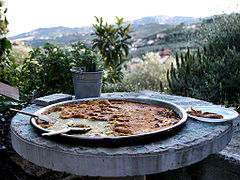 Gibraltarian Calentita is very similar to the Italian Farinata.
Gibraltarian Calentita is very similar to the Italian Farinata.
This article is part of a series on British cuisine  Regional cuisines
Regional cuisines- English cuisine
- Scottish cuisine
- Welsh cuisine
- Gibraltarian cuisine
- Cornish cuisine
- Irish cuisine
Overseas/Fusion cuisine Britain portal
Britain portalSavoury
Calentita
This is a locally baked bread-like dish, similar to the Italian farinata. It is made with chickpea flour, water, olive oil, salt and pepper. The word calentita comes from the Spanish word caliente, meaning hot or warm and has an oily texture. It was probably first given this name during the early 1900s when street vendors would shout out "Calentita!", informing people that it was fresh out of the oven. The last calentita street vendor, Paloma, is still remembered locally by the older generations.[1] Calentita is considered to be Gibraltar's national dish.[2]
Panissa
A bread-like dish similar to the calentita. Sharing its Italian origins, it is a descendant of the Genoese dish with the same name - "panissa". Unlike calentita the ingredients are first cooked in a pan to form a paste which is then left to set. When the polenta-like dough is set, it is cut into small strips and fried in olive oil.[3]
Sweet
Bollo de hornasso
A sweet and dry bread similar to the Spanish hornazo. It is made with self-raising flour, sugar, eggs, butter or margarine and aniseed. Bollos de hornasso are eaten around Easter just as in Spain, but in Gibraltar they are also popular during Christmas. Gibraltarian hornassos can normally be distinguished from the original Spanish hornazo as they do not tend to be decorated with hard-boiled eggs (however, Gibraltarian families of Spanish descent may still decorate them in this manner). It usually glazed with beaten egg and sometimes decorated with hundreds and thousands.[4]
Pan dulce
A sweet fruit and nut bread eaten at Christmas time. The term pan dulce means "sweet bread" in Spanish, but its origins lie in Italy with its ancestor being the panettone. Its main ingredients can include lard, margarine, sugar, self-raising flour, blanched almonds, raisins, sultanas, pine nuts, candied peel, eggs, aniseed and anisette among others. It is sometimes decorated with hundreds and thousands just like the bollo de hornasso.
History of pan dulce
Pan dulce is a staple food in Mexico and other Latin American countries. In the early 1800s the French introduced crispy rolls, baguettes, and rich pastries to Mexico. The French occupation of Mexico ended at the battle of Battle of Puebla (Cinco de Mayo) but the Mexican love of French bread remained. As the demand grew for this new bread, Mexican bakers quickly adopted the French techniques to make their own varieties. Everyone in Mexico seems to have a favorite, and there are many to choose from. It is said that the varieties of pan dulce number in the thousands, and they often have fanciful names. Some are the same shapes as you would find in France today but with a Mexicanized name. Since bread is inexpensive and filling, pan dulce has since become a key ingredient of the Mexican merienda.
Meat
Rolitos
A thin slice of beef surrounding breadcrumbs, bacon, eggs, olives, vegetables and herbs. These can be baked, fried or cooked in wine. Rolitos is another dish of Maltese origin, similar to braġjoli. It is also known as beef olives in English, even though some families prefer making them with pork or even chicken. The word rolito comes from the Spanish word rollo meaning 'roll', as the meat is rolled to hold the other ingredients inside.
Confectionery
Japonesa
The japonesa (Spanish: Japanese lady) is a sweet fried doughnut filled with a custard-like cream. Japonesas are usually enjoyed at teatime or as a snack. They are traditionally coated in syrup or granulated sugar.[5] The origin of its name is unknown but resembles the Japanese dorayaki.
See also
- Andalusian cuisine
- English cuisine
- Italian cuisine
- Maltese cuisine
- Mediterranean cuisine
- Portuguese cuisine
References
External links
Cuisine Outline Regional African · Americas · Arab · Asian · Caribbean · Central Asian · Eastern European · European · Sami · Latin American · Mediterranean · Middle Eastern · North African · South Asian · West African
National Afghan · Albanian · Algerian · American · Argentine · Armenian · Australian · Austrian · Azerbaijani · Bahraini · Bangladeshi · Belarusian · Belgian · Belizean · Beninese · Bhutanese · Bolivian · Bosnia and Herzegovina · Botswanan · Brazilian · British · Bulgarian · Burkinabe · Burmese · Cambodian · Cameroonian · Canadian · Catalan · Chadian · Chilean · Chinese · Colombian · Congolese · Croatian · Cuban · Cypriot · Czech · Danish · Dutch · Ecuadorian · Egyptian · English · Equatorial Guinean · Estonian · Ethiopian · Filipino · Finnish · French · Georgian · German · Greek · Guatemalan · Honduran · Hungarian · Icelandic · Indian · Indonesian · Iranian · Iraqi · Irish · Israeli · Italian · Ivorian (Côte d'Ivoire) · Jamaican · Japanese · Jordanian · Kazakh · Korean · Kuwaiti · Lao · Latvian · Lebanese · Libyan · Lithuanian · Luxembourg · Macedonian · Malagasy · Malaysian · Maltese · Mexican · Moldovan · Mongolian · Moroccan · Native American · Nigerian · Nigerien · Norwegian · Omani · Pakistani · Palestinian · Panamanian · Peruvian · Polish · Portuguese · Qatari · Romanian · Russian · Salvadoran · Saudi Arabian · Scottish · Serbian · Sicilian · Singaporean · Slovak · South African · Spanish · Sri Lankan · Sudanese · Swazi · Swedish · Swiss · Syrian · Taiwanese · Thai · Tunisian · Turkish · Trinidad and Tobago · Ukrainian · United Arab Emirati · Uruguayan · Uzbekistan · Venezuelan · Vietnamese · Welsh · Yemeni
Historical Styles Cuisine classique · Fast food · Fusion · Haute cuisine · Immigrant · Modernist · Molecular gastronomy · Nouvelle ·
Types of food Confectionery · Dairy products · Fruit · Herbs / Spices · Meat · Vegetable
Carbohydrate staples Types of dish Technical See also Food portal · Drink portal European cuisine Sovereign
states- Albania
- Andorra
- Armenia
- Austria
- Azerbaijan
- Belarus
- Belgium
- Bosnia and Herzegovina
- Bulgaria
- Croatia
- Cyprus
- Czech Republic
- Denmark
- Estonia
- Finland
- France
- Georgia
- Germany
- Greece
- Hungary
- Iceland
- Ireland
- Italy
- Kazakhstan
- Latvia
- Liechtenstein
- Lithuania
- Luxembourg
- Macedonia
- Malta
- Moldova
- Monaco
- Montenegro
- Netherlands
- Norway
- Poland
- Portugal
- Romania
- Russia
- San Marino
- Serbia
- Slovakia
- Slovenia
- Spain
- Sweden
- Switzerland
- Turkey
- Ukraine
- United Kingdom
- (England
- Northern Ireland
- Scotland
- Wales)
- Vatican City
States with limited
recognition- Abkhazia
- Kosovo
- Nagorno-Karabakh Republic
- Northern Cyprus
- South Ossetia
- Transnistria
Dependencies
and other territories- Åland
- Faroe Islands
- Gibraltar
- Guernsey
- Jan Mayen
- Jersey
- Isle of Man
- Svalbard
Cuisine of the Mediterranean Northern Africa Southern Europe European regions Western Asia Categories:- European cuisine
- Mediterranean cuisine
- British cuisine
- Gibraltarian culture
- Gibraltarian people
Wikimedia Foundation. 2010.

